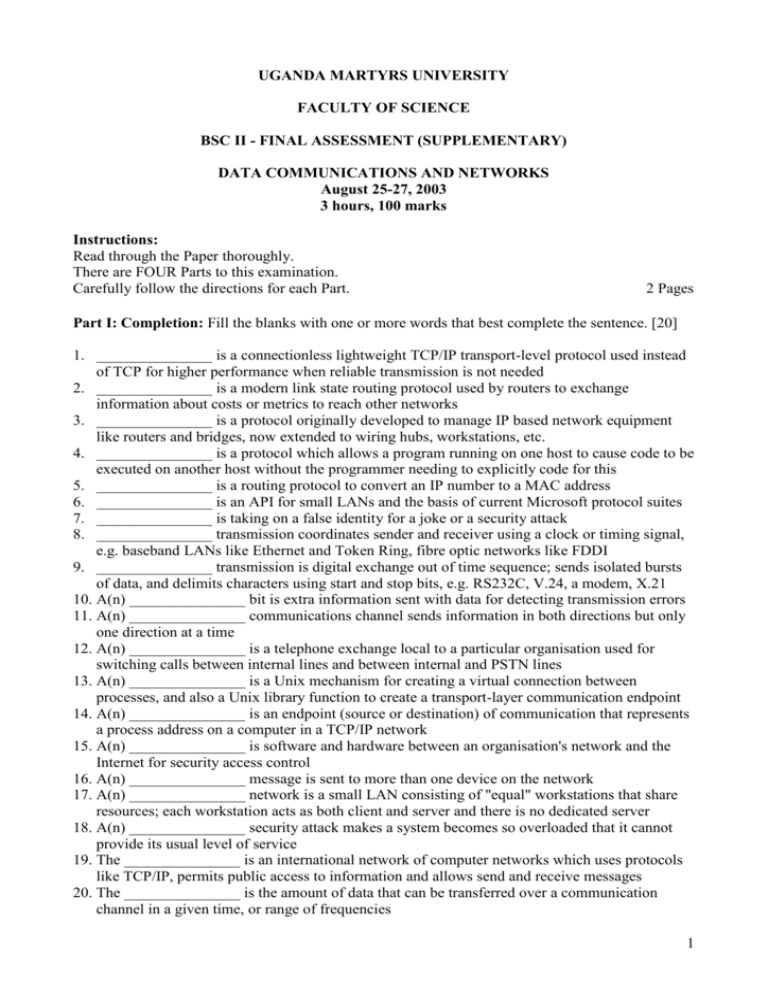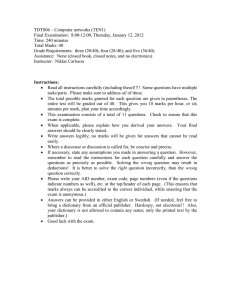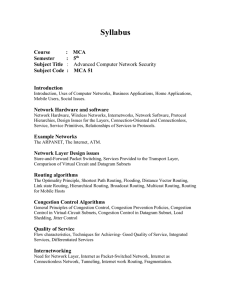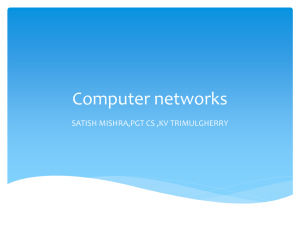Exam - www.gregvogl.net
advertisement

UGANDA MARTYRS UNIVERSITY FACULTY OF SCIENCE BSC II - FINAL ASSESSMENT (SUPPLEMENTARY) DATA COMMUNICATIONS AND NETWORKS August 25-27, 2003 3 hours, 100 marks Instructions: Read through the Paper thoroughly. There are FOUR Parts to this examination. Carefully follow the directions for each Part. 2 Pages Part I: Completion: Fill the blanks with one or more words that best complete the sentence. [20] 1. _______________ is a connectionless lightweight TCP/IP transport-level protocol used instead of TCP for higher performance when reliable transmission is not needed 2. _______________ is a modern link state routing protocol used by routers to exchange information about costs or metrics to reach other networks 3. _______________ is a protocol originally developed to manage IP based network equipment like routers and bridges, now extended to wiring hubs, workstations, etc. 4. _______________ is a protocol which allows a program running on one host to cause code to be executed on another host without the programmer needing to explicitly code for this 5. _______________ is a routing protocol to convert an IP number to a MAC address 6. _______________ is an API for small LANs and the basis of current Microsoft protocol suites 7. _______________ is taking on a false identity for a joke or a security attack 8. _______________ transmission coordinates sender and receiver using a clock or timing signal, e.g. baseband LANs like Ethernet and Token Ring, fibre optic networks like FDDI 9. _______________ transmission is digital exchange out of time sequence; sends isolated bursts of data, and delimits characters using start and stop bits, e.g. RS232C, V.24, a modem, X.21 10. A(n) _______________ bit is extra information sent with data for detecting transmission errors 11. A(n) _______________ communications channel sends information in both directions but only one direction at a time 12. A(n) _______________ is a telephone exchange local to a particular organisation used for switching calls between internal lines and between internal and PSTN lines 13. A(n) _______________ is a Unix mechanism for creating a virtual connection between processes, and also a Unix library function to create a transport-layer communication endpoint 14. A(n) _______________ is an endpoint (source or destination) of communication that represents a process address on a computer in a TCP/IP network 15. A(n) _______________ is software and hardware between an organisation's network and the Internet for security access control 16. A(n) _______________ message is sent to more than one device on the network 17. A(n) _______________ network is a small LAN consisting of "equal" workstations that share resources; each workstation acts as both client and server and there is no dedicated server 18. A(n) _______________ security attack makes a system becomes so overloaded that it cannot provide its usual level of service 19. The _______________ is an international network of computer networks which uses protocols like TCP/IP, permits public access to information and allows send and receive messages 20. The _______________ is the amount of data that can be transferred over a communication channel in a given time, or range of frequencies 1 Part II: Definition A. Define any five of these DCN terms. Clearly show your choices. [10] baseband, checksum, cracking program, datagram, hyperlink, intranet, Manchester encoding, packet, web server B. Decode and explain any five of these DCN acronyms. Clearly show your choices. [10] DES, DHCP, DNS, MAN, OSI, PKE, RIP, UTP, WWW Part III: Short Answer [50] A. Answer all of the following questions. [25] 1. List and briefly describe any five the seven layers of the OSI reference model. [10] 2. List three types of networked computer addresses and two protocols to convert between them. [5] 3. What features does TCP provide that IP does not? [5] 4. What measures can be taken to prevent and recover from viruses? [5] B. Answer five of the following questions. Clearly show your choices. [25] 1. 2. 3. 4. 5. 6. 7. 8. Explain and compare the features and shortcomings of two routing algorithms. [5] Explain the structure of an IP address and how it varies for different classes of networks. [5] Compare the structure of an IP datagram and a TCP segment. [5] Explain the purposes and uses of TCP ports. [5] Explain the structure of DNS. [5] How can a system administrator help secure user accounts? [5] How can a system administrator help protect user data? [5] Explain the purposes and uses of encryption. [5] Part IV: Longer Answer: Use your knowledge of DCN to explain in detail. [10] A user at Uganda Martyrs University clicks a link on the UMU intranet home page and another page on the intranet is displayed. Describe the interaction of hardware, software, media and protocols to make this happen. 2











